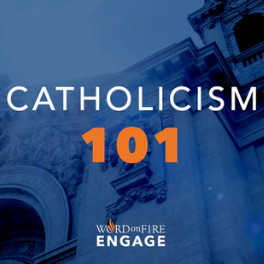 Each Sunday at Mass, we profess our faith. We proclaim what we believe via the Creed. A creed is a brief statement of faith used to list important truths, to clarify doctrinal points and to distinguish truth from error. The word creed comes from the Latin word credo, meaning, “I believe.” The Bible contains a number of creed-like passages. The Jews still recite a creed known as the Shema that comes from Deuteronomy 6:4-9 and the apostle Paul included several creed-like statements in his epistles, see 1 Timothy 3:16 and 1 Corinthians 8:6; 12:3; and 15:3-4. When properly used, creeds are of great help to the church. They provide a concise basis for teaching (most are written to be easily memorized), they safeguard correct (orthodox) biblical doctrine, and they help provide a focus for church fellowship.
Each Sunday at Mass, we profess our faith. We proclaim what we believe via the Creed. A creed is a brief statement of faith used to list important truths, to clarify doctrinal points and to distinguish truth from error. The word creed comes from the Latin word credo, meaning, “I believe.” The Bible contains a number of creed-like passages. The Jews still recite a creed known as the Shema that comes from Deuteronomy 6:4-9 and the apostle Paul included several creed-like statements in his epistles, see 1 Timothy 3:16 and 1 Corinthians 8:6; 12:3; and 15:3-4. When properly used, creeds are of great help to the church. They provide a concise basis for teaching (most are written to be easily memorized), they safeguard correct (orthodox) biblical doctrine, and they help provide a focus for church fellowship.
As the early church spread, there was the practical need to have a creed that would help believers focus on the most important doctrines of the Christian faith. Christians needed to distinguish themselves from many other competing religious ideas, not only the polytheism of the Romans and the monotheism of the Jews, but also heresies such as Gnosticism and Docetism. Gnosticism was based on a dualism of good and evil where gnosis, knowledge necessary for salvation, was randomly bestowed upon individuals. Salvation, thus, was not determined by God, but was random by nature. Docetism was the belief that Jesus only appeared to be human, similar to a mirage. This heresy arose as a way to explain how Jesus could be simultaneously both human and divine. The creedal statements of Eucmenical Coucils were written to address and clarify Christian belief – often in the face of heresies such as these. One of the early creeds was known as The Apostles Creed, not because its authors were the original apostles, but because it accurately reflects the apostles’ teaching. The creeds shared across Christianity are:
Apostles’ Creed: a creedal statement of the Roman Christians around A.D.180, who first developed an early form as a critique of those who held that the God of the Old Testament was malevolent as opposed to the God of the New Testament. It is shorter than the fuller (and later) Niceno-Constantinopolitan Creed adopted in 381, but it is still explicitly trinitarian in structure with sections affirming belief in God the Father, God the Son, and God the Holy Spirit. Since it pre-dates the Arian heresy, it does not address some Christological issues that were needed to be addressed in the Nicene Creed, thus says nothing explicitly about the divinity of either Jesus or the Holy Spirit.
The Nicene Creed:a creedal statement of the first ecumenical council in Nicaea (325 AD). The Nicene Creed was adopted to resolve the Arian controversy, whose leader, Arius, a clergyman of Alexandria, held that there was a hierarchy of divinity, i.e., Jesus was not fully divine as was God the Father and that Jesus was a created being. The Nicene Creed explicitly affirms the co-essential divinity of the Son, applying to him the term “consubstantial”.
The Nicene Creed (more properly known as the Nicaea-Constantinopolitan Creed – the one used in Mass): a revision of the earlier 325 AD creed, it was developed in 381 AD to include a new section on the Holy Spirit. It is the most widely accepted Christian creed. It critiques later heresies about Christ and Holy Spirit. But the creed’s “Filioque clause” resulted in disagreement between Eastern Christianity and Western Christianity. Here is a sample of the changes:
- We believe in one God, the Father Almighty, Maker of all things visible and invisible. (325 AD)
- We believe in one God, the Father Almighty, Maker of heaven and earth, and of all things visible and invisible. (381 AD)
The nature of this sequence of credal statements is that they are clarifying the Chrisitan beliefs already in place, but circumstances require a more precise detailing of the belief to the outside world. They do not define new belief or dogma.
Chalcedonian Creed: a creedal statement from the Council of Chalcedon (451 AD) developed in response to Nestorian teachings. This creed defines that Christ is “acknowledged in two natures”, which “come together into one person and one hypostasis”.